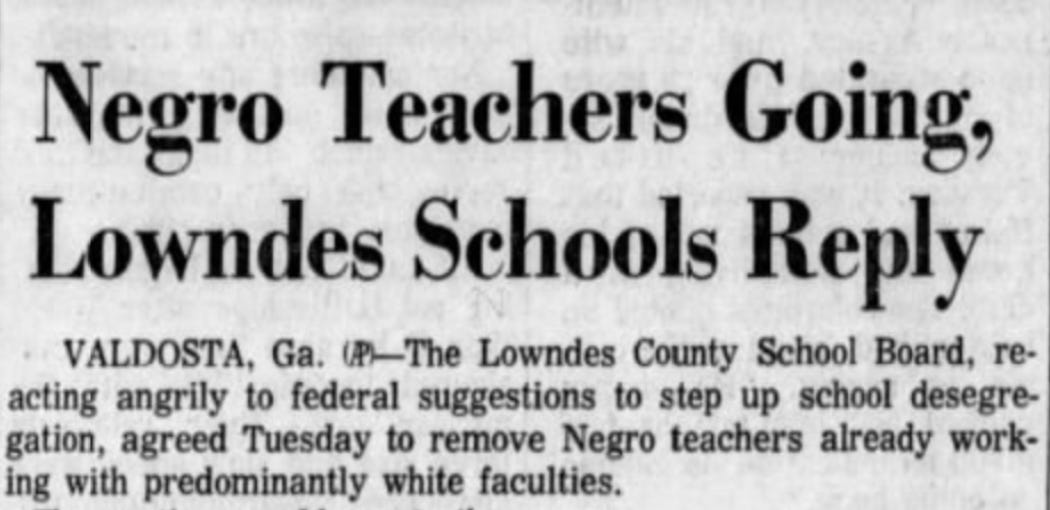"This really doesn't show much progress."
Lowndes County Schools (Georgia) and continued resistance to school integration
In early August 1967, representatives from the U.S. Department of Health, Education, and Welfare (HEW) met with the Lowndes County Board of Education (BoE) in Valdosta, GA. HEW made clear that they weren’t very happy with the pace at which the Lowndes County Schools were desegregating. “We are disappointed, especially in the faculty plan for this year, and the student increase if practically nothing,” Everett Waldo, a HEW representative said, “This really doesn’t show much progress.”
Lowndes County had been operating under a freedom of choice plan—which, purportedly, facilitated integration by allowing individual students to choose where to go to school. But, as the HEW folks pointed out, freedom of choice wasn’t doing much. So, HEW told the Lowndes County BoE they should prepare a full-scale desegregation plan. HEW wanted to see a plan outlining how Lowndes County would guarantee fully integrated schools over the next two to three years. In the meantime, HEW officials said, “Lowndes County should have at least 14 faculty crossovers this fall [the fall of 1967] and a minimum of 15 percent student desegregation.” By meeting these goals, the Lowndes County BoE would show HEW that they were making a good faith effort at integration.
That’s not what happened. They didn’t submit a plan.
Instead of complying with the HEW request, the Lowndes County BoE took retaliatory action against several Black employees in the district. Board member L. M. Tomlinson, a farmer who was supported by the segregationist organization Lowndes County Committee for Better Schools, brought forth a motion recommending the removal of Black teachers who were teaching in the county’s predominately white schools. “Let’s put them back where they belong,” Tomlinson said before noting, “I’m ready to go tend to my tobacco now.” For Tomlinson and and the majority of the board, this issue didn’t require much debate.
The removal of Black teachers from the county’s predominately white schools, though, would cost the district $342,000 worth of federal funds (or approximately $2,766,780 in 2021 dollars). “It’s a matter of doing it [integrating the schools] with or without the federal money,” Superintendent A. B. Martin pointed out, noting that federal courts could force integration regardless of what the board decided. But the superintendent’s warning didn’t gain any traction.
The Lowndes Country BoE went ahead and removed the Black teachers anyway. “You don’t give a damn about the white children,” Tomlinson told an HEW representative, making clear that the BoE’s action was really about protecting the white supremacist structures that organized life in the southern part of the state. And, of course, this white supremacist response found favor with Georgia’s governor.
Governor Lester Maddox had risen to power through his defiance of the Civil Rights Act of 1964. Shortly after President Lyndon B. Johnson signed the act into law, Maddox chased away three Black ministers from his Pickrick restaurant with an ax handle and a gun. After a lengthy court battle, Maddox chose to close the restaurant rather than integrate it. Two years later, he capitalized on a white backlash against Black civil rights advancements by becoming Georgia’s 75th governor.
So, when Maddox received word of the Lowndes County BoE’s stand against integration, he telegramed them his congratulations:
I commend you for your strong stand against Federal encroachment on your local school system… the greatest enemy of education in the United States is our own federal government—those who would force local citizens and their local representatives to surrender to the socialists in Washington and neglect our children, their teachers, their parents, and education… their dictates are contrary to the U.S. Constitution and the principles of Americanism.
Governor Maddox’s support for white supremacist politics such as the Lowndes County BoE’s retaliation against Black teachers would play out in a multitude of different ways during his time as governor. In 1969, Maddox would travel to Valdosta to commend this same community’s white citizens for opening a private segregation academy—thus, facilitating, at least rhetorically, the white abandonment of public schools.
If you’re interested in reading more about Maddox and segregation academies, please check out my article: For those who “love liberty and the American way of life”: Governor Lester Maddox and the opening of post-Brown segregation academies in Georgia.
More to come soon…
Primary Sources:
Baird, Joseph H. “Lester Maddox: Puritan in the Statehouse. The Reporter, October 5, 1967. Retrieved from the Lester Maddox Personality File, Kenan Research Center, Atlanta History Center, Atlanta, GA.
“Negro Teachers Going, Lowndes Schools Reply.” The Atlanta Constitution, August 2, 1967.


